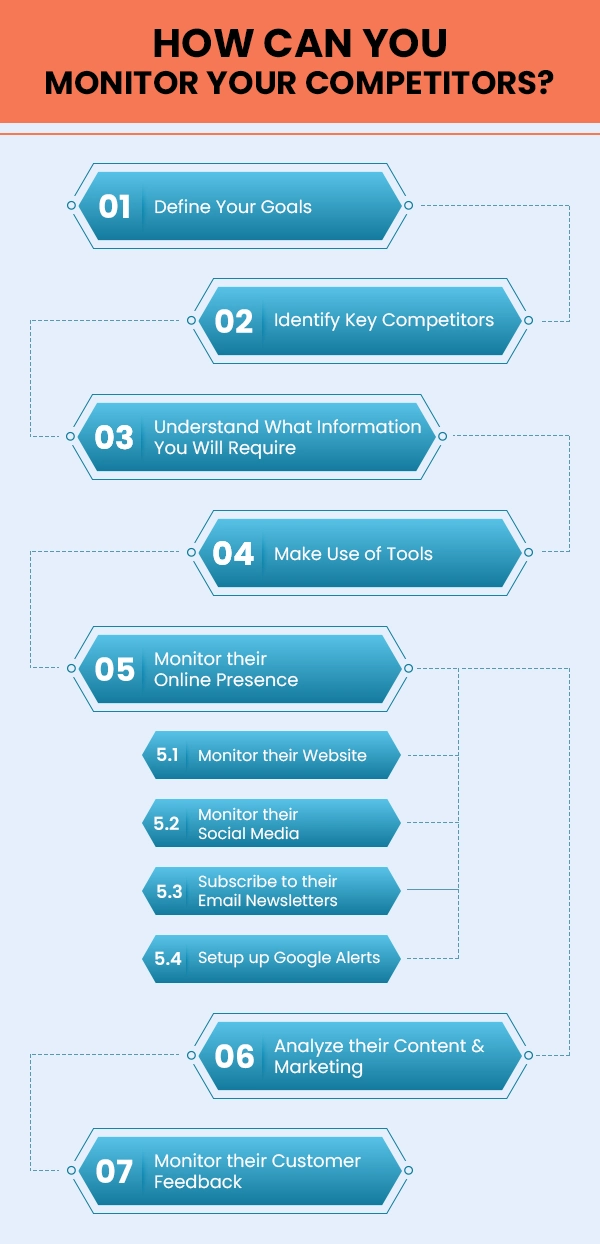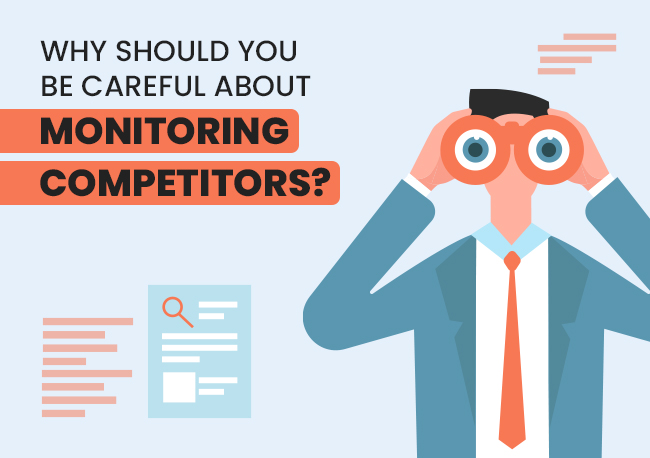| Getting your Trinity Audio player ready... |
We have often heard the saying, “keep your friends close and your enemies closer”. Similarly, it is important to keep an eye on what your competitors are up to. To do that, you can conduct thorough market research to identify competitors within your industry, which is essential when launching a business.
Given the multitude of businesses offering similar products and services, your venture is inevitably surrounded by competition. However, your ability to distinguish your business from the crowd hinges on how effectively you present your products or services to your target audience.
Upgrading your business tactic according to what is in trend and what your competitors use to get on top is essential.
Before we discuss the importance of being careful while monitoring your competitors, let’s first understand what competitor monitoring is and how it can be done.
What is Competitor Monitoring?
Simply put, competitor monitoring is the process of identifying, gathering, and analyzing information about your competitors. It involves systematically observing and evaluating their activities, such as their products, pricing strategies, marketing campaigns, customer service, and market positioning.
By understanding what your competitors are doing, businesses can gain valuable insights into market trends, customer preferences, and potential opportunities or threats. This knowledge enables companies to make informed decisions, refine their strategies, and stay ahead in the competitive landscape.
Effective competitor monitoring helps businesses adapt to market changes, enhances competitiveness, and fosters innovation.
Importance of being careful about Monitoring Competitors
- For Getting Strategic Market Insights
- To Understand Your Market Positioning
- To Get a Competitive Advantage
- For Improving Product Development
- For Determining Pricing Strategy
- For Determining a Marketing Strategy
- To Stay Updated About Market Trends
- For Getting Customer Insights
- To Improve Customer Satisfaction
- For Reputation Management
- Helps in Customer Retention
- For Getting Innovative
- For Measuring Your Business Performance
- For Adapting Changes in the Market
- For Global Expansion
- For Getting Investor’s Confidence
- To Get Aware About Regulatory Compliance
- For Identifying Opportunities & Threats
1. For Getting Strategic Market Insights
Competitive monitoring provides a window into the broader market environment, helping businesses understand trends, consumer behaviors, and emerging patterns.
➔ Use Case: A tech company notices a shift in consumer preference towards eco-friendly products. By monitoring competitors, they identify this trend early and adjust their product line to include sustainable options, gaining a strategic market advantage.
Also Read: Types Of Business Models Startups Should Know
2. To Understand Your Market Positioning
Analyzing competitors allows a business to assess where it stands in the market relative to others, facilitating the development of unique selling propositions.
➔ Use Case: A luxury fashion brand, through competitor analysis, discovers that competitors emphasize affordability. In response, the brand reaffirms its commitment to exclusivity and premium quality, strengthening its distinct market positioning.
3. To Get a Competitive Advantage
Careful monitoring enables businesses to identify gaps in the market, untapped customer needs, or areas where competitors may be falling short.
➔ Use Case: A restaurant observes that none of its competitors offer a gluten-free menu. By strategically introducing gluten-free options, the restaurant gains a competitive advantage and attracts a new customer segment.
4. For Improving Product Development
Studying competitors’ products helps in enhancing a company’s own product development by identifying features, technologies, or design elements that resonate with customers.
➔ Use Case: An electronics manufacturer analyzes competitors’ smartphones and identifies a popular feature. They integrate a similar feature into their new product, enhancing its appeal and competitiveness in the market.
Also Read: Types Of eCommerce Websites And Models
5. For Determining Pricing Strategy
Monitoring competitors’ pricing strategies aid in setting competitive yet profitable prices that align with market expectations.
➔ Use Case: A software company, by analyzing competitors, discovers a similar product offered at a lower price. After evaluating the additional features of their product, they adjust the price to maintain competitiveness without compromising value.
6. For Determining a Marketing Strategy
By examining competitors’ marketing efforts, businesses can identify effective strategies and tailor their own campaigns for maximum impact.
➔ Use Case: A beverage company notices a competitor’s successful social media campaign. Inspired, they launch a similar campaign, resulting in increased brand visibility and engagement.
Also Read: Brand Strategy Vs Marketing Strategy – Know The Difference
7. To Stay Updated About Market Trends
Competitor monitoring keeps businesses informed about evolving market trends, ensuring they remain at the forefront of industry developments.
➔ Use Case: A fashion retailer, through competitor analysis, identifies the growing trend of sustainable fashion. They adjust their inventory, promoting eco-friendly brands, and capitalize on the rising consumer demand for sustainable products.
8. For Getting Customer Insights
Analyzing competitors provides valuable insights into customer preferences, helping businesses tailor products and services to meet customer expectations.
➔ Use Case: An online streaming service notices that a competitor’s users appreciate personalized playlists. They incorporate a similar feature, enhancing user satisfaction and retention.
Also Read: Blog VS Website: The Difference You Need To Know As A Beginner
9. To Improve Customer Satisfaction
Learning from competitors’ successes and failures in customer satisfaction strategies helps in enhancing a company’s own customer service and support.
➔ Use Case: An e-commerce business, after seeing a competitor receive positive reviews for quick and hassle-free returns, improves its return process, leading to increased customer satisfaction and loyalty.
10. For Reputation Management
Competitor monitoring allows businesses to identify potential reputation threats early, enabling proactive measures to manage and protect brand image.
➔ Use Case: A restaurant observes negative reviews about a competitor’s cleanliness. Taking preventive action, the restaurant emphasizes cleanliness in its marketing and ensures rigorous hygiene standards, safeguarding its reputation.
11. Helps in Customer Retention
Understanding how competitors engage with their customers allows businesses to implement effective customer retention strategies, reducing customer churn.
➔ Use Case: A subscription-based service, noticing a competitor’s successful loyalty program, introduces a similar initiative, leading to increased customer retention and higher subscription renewals.
12. For Bringing Innovation
Continuous competitor monitoring inspires innovation by exposing businesses to new ideas and approaches within their industry.
➔ Use Case: An automobile manufacturer, by observing competitors’ advancements in electric vehicles, invests in research and development to introduce its line of electric cars, staying ahead in the innovation curve.
13. For Measuring Your Business Performance
Benchmarking against competitors aids in objectively assessing a company’s performance and identifying areas for improvement.
➔ Use Case: A software company regularly compares its customer satisfaction ratings with those of its main competitor. Any noticeable gaps prompt the company to refine its customer service strategies for improved performance.
14. For Adapting Changes in the Market
Keeping an eye on competitors enables businesses to proactively adapt to market changes, ensuring long-term viability.
➔ Use Case: A retail chain, noticing competitors’ success in online sales, accelerates its e-commerce strategy, adapting to the changing consumer preferences and market dynamics.
15. For Global Expansion
Understanding international competitors is crucial for businesses eyeing global expansion, considering diverse market dynamics.
➔ Use Case: A technology company planning to expand globally studies competitors’ strategies in different regions, helping them tailor their market entry approach for maximum success.
16. For Getting Investor’s Confidence
Investors seek companies with a thorough understanding of their competitive landscape, instilling confidence in the business’s strategic acumen.
➔ Use Case: A startup, backed by comprehensive competitor analysis in its pitch, secures investor confidence by showcasing a clear understanding of market dynamics and potential challenges.
17. To Get Aware About Regulatory Compliance
Monitoring competitors helps businesses stay informed about regulatory changes and compliance requirements, avoiding legal pitfalls.
➔ Use Case: A pharmaceutical company monitors competitors’ adherence to new industry regulations, ensuring its own processes align with the latest compliance standards, preventing legal issues.
18. For Identifying Opportunities & Threats
Competitor analysis identifies both opportunities for growth and potential threats, aiding in the formulation of a robust business strategy.
➔ Use Case: An insurance company, through competitor monitoring, identifies an untapped niche market. They tailor their products to address this segment, seizing an opportunity for business expansion while mitigating potential threats from new market entrants.
Let’s have a recap of what we learned about the importance of being careful about monitoring competitors with an infographic below:

Also Read: Will ECommerce Dominate Physical Stores – What’s The Future?
By this point, you likely have a basic understanding of competitor monitoring. However, understanding the process and how to execute it effectively might still be a question. Let us take an example to understand the process in detail.
Imagine you work for a company that manufactures smartphones. To stay competitive in the market, you decide to conduct competitor monitoring. Here’s how you can go about it:
1. Defining Your Goals
Monitoring your competitors effectively begins with clearly defining your goals. Start by identifying specific aspects you want to track, such as their marketing strategies, product offerings, customer engagement, or market positioning.
These goals should align with your business objectives, whether to enhance your marketing tactics, improve products, or identify potential gaps in the market. You can focus on gathering relevant data and insights by setting precise goals.
For instance, if you want to understand their digital marketing approach, you might track their social media activities, ad campaigns, and website updates. Regularly revisiting and refining your goals is crucial as the competitive landscape evolves.
Clear objectives guide your monitoring efforts and help you interpret the gathered data effectively, enabling strategic decision-making for your business.
Also Read: What Makes A Good Website Checklist? A Complete Guide
2. Identify Key Competitors
Monitoring your competitors is crucial for staying ahead in the business world. To identify key competitors, research companies operating in your industry or niche, look for businesses offering similar products or services, target the same customer base, or compete for the same market share.
Analyze their strengths, weaknesses, market presence, and customer reviews. Utilize online tools and industry reports to gather insights. Social media platforms can provide valuable information on marketing strategies and customer engagement. Attend industry events and conferences where competitors might showcase their products or services.
By understanding who your key competitors are, you can focus your monitoring efforts effectively. Regularly assess their activities, pricing strategies, product launches, and customer feedback to adapt your business strategies and maintain a competitive edge. Stay vigilant, adapt to market changes, and continuously innovate to outperform your rivals.
In the case of a smartphone manufacturing company, the key competitors will be:
➢ Primary Competitors: Identify major players in the smartphone industry, such as Apple, Samsung, and Huawei.
➢ Secondary Competitors: Include emerging companies that pose a threat in the future, like Xiaomi or OnePlus.
Also Read: 15 Best Websites For Entrepreneurs In 2023
3. Understand What Information You Will Require
Monitoring your competitors is essential for staying ahead in the business world. You must identify who they are and what they offer to track your competitors effectively. This includes understanding their products or services, pricing strategies, target audience & target market, marketing techniques, and overall market positioning.
Next, you’ll need to gather information on their strengths and weaknesses, customer reviews, and any recent changes in their business approach. Additionally, keeping an eye on their online presence, social media activities, and customer engagement can provide valuable insights.
By consistently analyzing this information, you can adapt your strategies, identify market gaps, and make informed decisions to maintain a competitive edge in your industry.
➢ Product Features: Monitor the features and specifications of your competitors’ smartphones. For instance, Apple might release a new iPhone with innovative facial recognition technology.
➢ Pricing Strategies: Analyze the pricing strategies of competitors. Samsung might launch budget-friendly phones to capture the lower-end market.
➢ Marketing and Promotion: Look into their marketing campaigns and promotional activities. Huawei might focus on highlighting their phones’ superior camera capabilities.
➢ Customer Reviews: Pay attention to customer reviews and feedback about competitors’ products. This can provide insights into customer satisfaction and areas for improvement.
Also Read: Digital Marketing Strategies For Catering Business
4. Make Use of Tools
To effectively keep an eye on your competitors, start by identifying who they are and what they offer. Utilize tools like market research platforms, social media analytics, and competitor analysis software to track their online presence, customer engagement, and product offerings.
These tools can help you gather valuable insights into their strategies and customer feedback. Analyze this information to identify trends, strengths, and weaknesses. By understanding your competitors’ moves, you can adapt your strategies, innovate products, and enhance customer experiences, ensuring you remain competitive and agile in the market.
Remember, knowledge about your competitors is not just power; it’s a strategic advantage that can drive your business forward.
In our example, the manufacturer of smartphones must identify the following factors in order to obtain a better understanding of the products and services provided by their rivals and to make effective use of the tools and strategies they use.
➢ Strengths and Weaknesses: Identify the strengths and weaknesses of each competitor. For example, Apple’s strength might be its brand loyalty, while a weakness could be its high pricing.
➢ Market Positioning: Determine how competitors position themselves in the market. Samsung might focus on offering a wide range of products to cater to different customer segments.
➢ Trends and Innovations: Analyze industry trends and innovations. If several competitors are investing in 5G technology, it might indicate a shift in the market.
➢ Making Strategic Decisions: Businesses can utilize competitive analysis tools to track market trends, benchmark performance, and identify strengths and weaknesses. By analyzing this data, companies can gain valuable insights, enabling informed decision-making to stay ahead in the market.
Also Read: How To Organize The Content Of Your Website?
5. Monitor their Online Presence
Monitoring your competitors and tracking their online presence is crucial in today’s digital age. To do this effectively, start by identifying your main competitors in your industry or niche. Utilize online tools and platforms to track their website activities, social media engagement, and content strategies.
Pay attention to their website updates, blog posts, social media posts, and customer interactions. Analyze the keywords they are targeting, the type of content they are producing, and their social media engagement metrics. Additionally, keep an eye on their online reviews and customer feedback to gauge their reputation.
By consistently monitoring your competitors, you gain valuable insights into their strategies, allowing you to adapt and refine your approach to stay ahead in the market. Stay vigilant, analyze the data, and respond proactively to industry trends and customer demands to maintain a competitive edge.
➢ Monitor their Website
Monitoring your competitors and tracking their online presence through their websites is essential for staying ahead in the competitive landscape. Start by thoroughly analyzing your competitors’ websites, focusing on their content, design, user experience, and any unique selling propositions they might have.
Regularly check their product offerings, pricing strategies, and customer engagement techniques. Check their website analytics and SEO analysis to understand their online traffic sources and keywords. Additionally, keep an eye on their social media integration and online reviews.
By staying vigilant and continuously assessing your competitors’ digital footprint, you gain valuable insights that can help you refine your strategies, enhance your offerings, and maintain a competitive edge in the market.
Also Read: How Much Traffic Does This Website Get? 7 Ways To Check
➢ Monitor on Social Media
In this competitive landscape, keeping an eye on your competitors’ online presence is essential, especially on social media platforms. You can start by identifying their social media channels, such as Facebook, Twitter, Instagram, and LinkedIn.
Follow and analyze their posts, engagements, and audience interactions. Pay attention to the type of content they share, their posts’ frequency, and how their audience responds. Utilize social media monitoring tools to track mentions, hashtags, and comments related to their brand.
Understanding their strategies and customer interactions allows you to gain valuable insights into market trends, customer preferences, and potential opportunities. This knowledge equips you to make informed decisions, refine your strategies, and stay ahead in the market.
➢ Subscribe to their Email Newsletters
One of the effective ways to track every movement of your competitors’ is by subscribing to their email newsletters. Doing so gives you direct insight into their marketing strategies, product launches, and promotional offers.
This allows you to analyze their content, design, and overall approach, helping you identify trends and patterns that can inform your marketing efforts.
Additionally, observing how frequently they send newsletters and the kind of information they share provides valuable data about their engagement tactics and customer outreach.
By staying updated through their newsletters, you understand their market positioning and enhance your strategies to maintain a competitive edge in the industry.
Also Read: 11 Benefits Of Email Marketing For Small Businesses In 2023
➢ Setup up Google Alerts
You can effectively monitor your competitors’ online presence by setting up Google Alerts. First, identify your key competitors and the specific industry-related keywords you want to track. Then, go to Google Alerts and enter these keywords along with your competitors’ names.
Google Alerts will notify you via email whenever new content containing these keywords or competitors is published online. This real-time tracking helps you stay updated on competitors’ activities, product launches, and marketing strategies.
By analyzing this information, you can gain valuable insights, identify market trends, and make informed decisions to stay ahead in the competitive landscape. Setting up Google Alerts is a simple yet powerful way to watch your competitors closely and enhance your business strategies.
6. Analyze their Content & Marketing
Monitoring your competitors and analyzing their content and marketing strategies is crucial for staying ahead in the competitive business landscape. To effectively monitor your competitors, identify your industry’s key competitors.
Utilize online tools and platforms to keep track of their website updates, social media activities, and email campaigns. Analyze their content, such as blog posts, videos, and social media posts, to understand their messaging, tone, and engagement strategies.
Additionally, assess their marketing tactics, including promotions, discounts, and collaborations, to gain insights into what resonates with their audience.
By staying informed about your competitors’ activities, you can adapt your strategies, identify potential gaps in the market, and make data-driven decisions to enhance your content and marketing efforts, ultimately fostering business growth and a competitive edge.
Also Read: What Should You Consider When Developing Website Content?
7. Monitor their Customer Feedback
Keep an eye on their customer feedback by following reviews on various platforms like social media, review websites, and industry-specific forums. Analyze the feedback to identify common issues, preferences, and trends among their customers.
This information can provide valuable insights into areas where your products or services can improve. Additionally, understanding your competitors’ customer satisfaction levels can help you better tailor your offerings to meet customer expectations.
Stay vigilant and adapt your strategies based on the feedback gathered, ensuring your business remains competitive and customer-focused.
Let’s have a recap of what we learned about how you can monitor your competitors with an infographic below:

Also Read: How Can You Make A Website Look More Professional?
Conclusion
In summary, monitoring competitors is indispensable for businesses across various operations.
To adapt to market changes, businesses must keenly observe competitors to gain insights into industry trends and consumer preferences. However, this must be done thoughtfully, avoiding mindless imitation to maintain originality and brand identity.
Understanding the diverse market dynamics is crucial for global expansion, requiring a nuanced approach considering cultural differences and legal complexities. Investors, evaluating a company’s potential, look for strategic market awareness integrated with innovative ideas, emphasizing the need for a balanced use of competitor insights.
Moreover, staying aware of regulatory compliance is vital, requiring careful validation of competitors’ actions to prevent misconceptions. To effectively monitor competitors, businesses should start by defining clear goals aligned with their objectives.
Identifying key competitors, understanding necessary information, and utilizing various tools such as market research platforms and social media analytics are essential steps.
Monitoring competitors’ online presence, website activities, social media engagements, and email newsletters while analyzing their content, marketing strategies, and customer feedback provides valuable insights. Additionally, setting up Google Alerts enables real-time tracking of competitors’ activities, ensuring businesses stay informed about market trends and make data-driven decisions.
A balanced, cautious, and proactive approach to competitor monitoring empowers businesses to adapt, innovate, and maintain a competitive edge while upholding integrity and legality.
FAQs
Monitoring competitors helps marketing teams stay informed about industry trends, adapt strategies, and identify competitive advantages, ensuring a proactive approach in the market.
When monitoring competitors, focus on their product offerings, pricing strategies, and marketing tactics. Analyze customer reviews, market positioning, and emerging trends to make informed business decisions. Regularly assess their online presence, social media engagement, and customer feedback to stay ahead.
Conducting competitor analysis periodically is crucial for staying informed about market trends and competitors’ strategies. The frequency depends on industry dynamics; a quarterly or biannual review often proves effective in most sectors, ensuring timely adjustments to your marketing strategies.
Neglecting competitors risks losing market insights, innovation opportunities, and a competitive edge. Monitoring ensures adaptability and strategic planning, which are vital for sustained business growth.




